Meili Snow Mountain To Cizhong
9-day Trekking
Adventure Tour
Highlights:
* Hike and explore the majestic and mysterious Meili Snow
Mountain, which is regarded as the holiest mountain in all of
Tibetan Buddhism
* Wander and walk among traditional local villages, and
experience their customs and lifestyle
* Spend time in Shangri-la, a place once thought to only be a
fantastic legend, but actually a true and real paradise on earth
The best season for visiting Mt.Kawagebo(6,740m/22,107ft) is in
the fall time and it must be clear day. The snow-capped Mountains,
whose every peak is the subject of an enchanting tale. The glacier
at the foot of the peak extends 11,000 feet downward to a
surprisingly low level, seeming to plunge into the Lancang (Mekong )
River. Tucked away at the foot of Mt. Kawagebo, one of Tibet's most
sacred mountains, is the stunningly beautiful and isolated village
of Yubeng. With the exception of the occasional mountain climbing
expedition and Buddhists on a pilgrimage to the mountain and sacred
waterfall a half-day's walk away, Yubeng is rarely visited by
outsiders. The villagers' timeless way of life - herding yak,
plowing the fields and fetching water from the nearby glacier stream
- has changed little over the centuries. This trip will start from
Kunming, the capital of Yunnan Province, and take us to the
northwestern part of the province on the Tibetan Plateau. We will
follow the same trail that pilgrims take on their way to Mt.
Kawagebo.
Several attempts have been made to conquer Meli Mountain since
1990, but all failed. This pilgrim trekking has more than 600 years
history, the scenery on the way is breathtakingly beautiful, the
ecology system is well preserved, even the animals you meet are not
afraid people because nobody want to hurt them, all the villagers
are very friendly and hospitable. You will not believe it until you
come to take this trekking by yourself. We think this is the most
classic trekking route in China. You bet it will be
unforgettable!
Itinerary
Day1: Kunming/Zhongdian (Shangri-la) (by plane )
You will fly to Kunming, capital of Yunnan province, and you
will then transfer and make the short flight to Zhongdian, also
known as Shangri-la. Upon arrival you will be met by your
English-speaking guide. Many snow-capped mountains surround
Shangri-la. Of these, the three well known ones are Meili,
Balang, and Haba mountains. The Tibetans consider these
mountains sacred. Meili Mountain is famous for its highest peak:
Kang Karpo, towering over Yunnan at 6740 meters above sea level.
Thirteen lesser peaks, each more than 6000 meters above sea
level, surround it. Kang Karpo peak is shrouded in mists and
clouds most of the time. Meili is one of the eight sacred
mountains the Tibetans worship. Beneath Kang Karpo, the Mingyong
and Sinong glaciers stretch down to a level of 2700 meters.
Because of its changeable climate, Meili Mountain is fraught
with danger and remains unconquered until today.
On your drive into the city, we will see the world*s largest
Buddhist prayer wheel, and we will also make a stop at the Songzhanling Monastery, which is right outside the city. This
Large Yellow Hat (Gelupa) Tibetan monastery has returned from
the ashes and destruction that swept southeastern Tibet in the
late 1950s and 1960s . Songsenlin was founded in the 17th
century during the reign of the Great Fifth Dalai Lama , when
the yellow Hat school came to full ascendancy in Tibet . it lies
a few kilometers beyond the north end of town and welcomes
visitors who behave respectfully.
The monastery once had as many as 1200 monks before, and now
claims many hundreds, though most of these stay at home and work
with their families, only coming together as a single body on
area festival occasions . In 1980 the second delegation sent by
the Dalai Lama to investigate conditions in Tibet stayed in
Zhongdian , and since then there has been steady reconstruction
at this sacred site.
You will then go to your hostel for the evening, and you are
free to spend your time at your won leisure. You might want to
rest up, because tomorrow we begin our journey!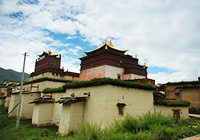 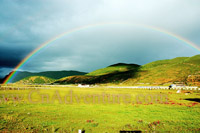
Day2: Zhongdian (Shangri-la-Temple
Flown from Afar (200km/124 miles of driving, B, L, D)
After breakfast in the hostel we will begin our drive to the
Faeilaisi Temple (Temple Flown From Afar). Along the way we will
stop to take pictures of the stunning scenery, and we*ll pass
some authentic small Tibetan villages. We*ll also drive through
the Baimang Snow Mountain Nature Reserve, where if the weather
is clear, you can view Baimang Snow Mountain (4,200m/13,776ft).
The nature reserve is one of the most vital and important sites
for bio-diversity for the Great Rivers Project, which is
sponsored by the Natural Conservancy.
After traversing some of the mountain ranges and having lunch at
a local town, we*ll take some pictures of the First Bend of Jinsha (Yangtze) River, Dongzhulin Monastery, and Baimang (White
Horse) Snow Mountain. The view along the way is fantastic with
different kinds of trees, streams down the valley, prayer flags
and stupas, and Tibetan villages.
Then we will arrive at the Feilasi Temple. It has a legend that
the temple was built by one Sakyamuni Buddha who flying to here
from Tibet. It is the place for Tibetans to pay homage to the
sacred mountains and it is said that circumambulators must get
the key in Qidengge. Circumambulators who are in inside
circumambulation must get the key in Yongzongbajiu Temple at the
bank of Lancang River besides the key in Qidengge. In recent
years, Buddhist activities of various kinds are all held at the
Wulongding Culture Square and Feilaisii Temple.
We*ll spend the night in a local hostel near the Feilaisi
Temple, and if the weather is good enough, we*ll get a good view
of all 13 peaks of Meili Snow Mountain.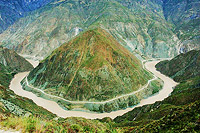 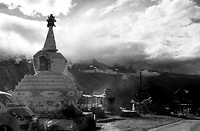
Day3: Feilaisi Temple-Xidang Hot Spring
(15km/9.3miles, 7 hours of hiking, B, L, D)
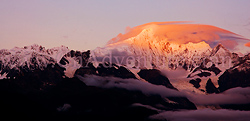 Early
after breakfast, we*ll follow a trail descending steeply to
the Mekong River, where we will begin our trek to Meili Snow
Mountain. We*ll cross a bridge and climb up along the
terrace fields to Xidang Village, where we will have our
lunch. Xidang has electricity and several rustic lodges.
We*d better hike 2km/1.2miles further up to Hot Springs (Wenquan),
and we*ll stay overnight at the Wenquan Lodge in order to
get a head start on the next day*s trek. Early
after breakfast, we*ll follow a trail descending steeply to
the Mekong River, where we will begin our trek to Meili Snow
Mountain. We*ll cross a bridge and climb up along the
terrace fields to Xidang Village, where we will have our
lunch. Xidang has electricity and several rustic lodges.
We*d better hike 2km/1.2miles further up to Hot Springs (Wenquan),
and we*ll stay overnight at the Wenquan Lodge in order to
get a head start on the next day*s trek.
Day4: Xidang Village-Yubeng Village (14km/8.7
miles, 6 hours of hiking, B, L, D)
Today*s hiking will be long and hard, so be prepared for a
very physical day. Following breakfast our first section of
hiking will take about 4 hours to reach the Mountain Pass.
The path zigzagging under the canopy of trees is quite damp
and muddy. A Tibetan house, located at one-third of the
route, sells snacks and drinks. A breathtaking view can be
spotted at Nazongla Pass. Once we reach the summit we will
have ourselves a picnic lunch, and if we*re in the early
spring, there still may be some snow on the ground.
We will then begin our descent to the village of Yubeng
where we*ll spend the night. Yubeng Village is a beautiful
and miraculous place. When walking in the village, tourists
will have a sense of walking at Shangri-la. Located at the
back of the Meli Snow Mountains, it is surrounded by
mountains. Because of its unique location, there are only 20
households living here and connects outside world only with
one small road. Yubeng Village is divided into upper village
and lower village. From upper village, tourists can go to
the base camp of the Joint Sino-Japanese,while from the
lower village, tourists can go to Yubeng Waterfall, Ancient
Seal Character and other scenic spots.
The descent from Nazongla Pass to the upper Yubeng Village
takes about 2 hours. Upon arriving at the village, we*ll
take the trail turning to the left, walk further down to a
stream, cross a bridge and climb a small slope up to the
lower Yubeng Village. At the end of the village, you can
find Aqinbu's Shenpu Lodge, where we*ll be spending the
night.
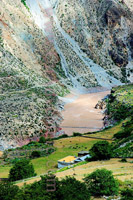 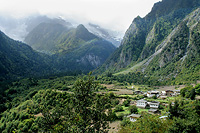
Day5: Yubeng Village-Base Camp-Yubeng
(18km/11miles, 7 hours of hiking and back, B, L , D)
In the morning, we will hike up to the Kawa Karpo
Mountaineering base camp, starting with a climb up to the
mountain pass through its virgin forests, and we*ll see many of
the dead woods along the way. After enjoying the panoramic view
from the mountain pass, we*ll walk down a horse road and reach
the base camp. This base camp is where the daring adventurers of
yesteryear would embark on their climb up Kawa Karpo. At the
base camp we*ll enjoy the view of mountain ice caps, lakes of
ice, and the rest of the sweeping scenery.
After spending some time at the base camp we will hike back to
our hostel at Yubeng village, where we*ll spend the evening
again.
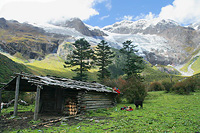 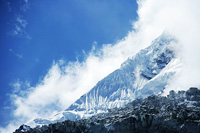
Day 6: Yubeng Village-Sacred Waterfall-Yubeng
(14km/8.7miles, 4 hours of hiking and back, B, L, D)
If the weather is clear enough, we*ll wake up with a view of
the Mt. Kawgebo glacier. After breakfast we will begin our hike
to the Sacred Waterfall, from which the village of Yubeng got
its name. On our way to the waterfall we will see a holy
monastery called Lakang, with its distinctive white pagoda.
We*ll get a close-up view of the grand peaks of Mianchumu and
Jiwaren*an. We*ll also see archaic virgin forests, mountain
willows, sand thorns, the original site of Yubeng village, where
sits the practice cave of the Buddhist master Padmasambhava.
The waterfall is a sacred place for Buddhists on pilgrimage to
the area, and they circumambulate the waterfall 13 times in the
belief that this act will erase all sins from this life. Maybe
you can give it a try!
After a picnic lunch on the pastures around the waterfall we
will begin our trek back to Yubeng village, and along the way we
will visit some more of the sacred Buddhist pilgrimage sites on
our way back. Our evening will again be spent at our hostel in
Yubeng village.
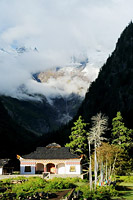 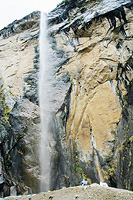 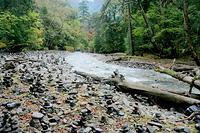
Day 7: Yubeng village-Yanmen town
(25km/15.5miles, 8 hours of hiking, 1 hour of driving, B, L,
D)
We will spend our morning walking down in the Yubeng
Valley. The Yubeng River flows all the way into the Mekong
River. Parts of the trail we will cover are actually a canal
dig along the halfway mountain by local villagers. And the
altitude drops also to 1,900m(6,232ft), causing quite
different views on the way, and you might feel a little
different yourself!
After giving lunch in the little village of Ninong, we will
cross the Mekong River and hike for 2 more hours to Jiabi
Village, and from there we will switch to a van and drive to
the town of Yanmen. At Yanmen we will stay in a hostel for
the night.
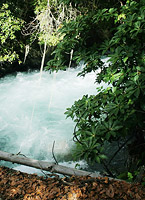 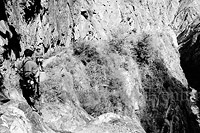 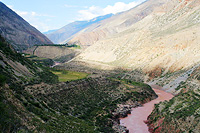
Day 8: Yanmen town-Shigu Town
(240km/149miles, 7 hours of driving, B, L, D)
Following breakfast we will drive for about an hour to the
village of Cizhong in order to visit the Cizhong Christian
Church, which was built by French missionaries in the last
century. The Cizhong Church is one
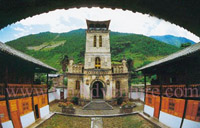 of
the few churches in Tibet that survived the Cultural
Revolution. The church, built at the beginning of the 20th
century, is a unique fusion of French and Chinese
architectural styles. The overhanging eaves and roof of the
church are Chinese style, while the cross on top is Western
style. The Cizhong municipal government repaired the church
in 1989 and then opened it to the public. of
the few churches in Tibet that survived the Cultural
Revolution. The church, built at the beginning of the 20th
century, is a unique fusion of French and Chinese
architectural styles. The overhanging eaves and roof of the
church are Chinese style, while the cross on top is Western
style. The Cizhong municipal government repaired the church
in 1989 and then opened it to the public.
In the afternoon we*ll take a bus along the Mekong River to
the town of Shigu, where the First Bend of the Yangtze River
passes by. On the way we will stop at the ethnic villages of
Shuhe and Taiping. Shuhe Naxi Village, also known as
Longquan Village by the local people, is the earliest
habitation for the Naxi ancestors near Lijiang, and one of
the most well preserved important markets along the
Tea-Horse Ancient Road. The Taiping village is home to the
Lisu ethnic group, a Tibeto-Burman ethnic group who inhabit
the mountainous regions of Burma (Myanmar), Southwest China,
Thailand, and the Indian state of Arunachal Pradesh. They
mainly inhabit the remote country areas
We will then reach Shigu town, and it is only about 50
kilometers or 30 miles away from Lijiang. It is called the
*first bend* because the river makes a 90 degree turn from
south to east within a distance of 1 kilometer. It is only
about 50 kilometers or 30 miles away from Lijiang. It is
called the *first bend* because the river makes a 90 degree
turn from south to east within a distance of 1 kilometer.
The place was important militarily because big armies
crossed the river at that point, and it was a place where
Tibetans came down to trade with the people living in the
area. The town of Shiguzhen is at the bend, and there is a
market area where people come to buy and sell goods. The
land around the river is passable on foot, but mountains
block the region south and north of it, so it was an
important route for armies marching through the region.
We*ll spend the night further exploring Shigu, and we*ll
spend the evening in a hostel in the town.
Day 9 Shigu town-Lijiang (67km/41.6miles, 2 hours
of driving, B)
Following breakfast we will make the drive to Lijiang,
and you*ll be taken to the airport, where you will fly
to your next destination, ending your adventure among
the mountains.
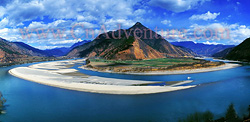
Remarks before reservation:
. The participants we are looking for:
without acrophobia, heart disease。Walking 7-10 hours plus a
day; crossing high altitude passes over difficult terrain in
remote areas; excellent physical condition required with a
positive attitude and a strong determination; previous
hiking/camping experience preferred. Please keep in mind that
this is a general guide only. A variety of factors, including
weather, may add to the challenge.
. This is a tentative itinerary. For the
enjoyment of your trip a "go with the flow" attitude is
necessary. Many factors will influence your trip, such as
weather conditions, health, route conditions, etc. Please
prepare two days more as "cushion" day in case of delays in
travel due to unforeseen events.
. If there are less than six persons in a
group, we reserve the right to cancel the expedition. In this
case we inform you two month before the departure time and
will return all the money you paid. Please understand!
. Regardless of your previous HA experience,
it is crucial that you be self-confident, superbly fit,
committed, and determined at the outset of the expedition and
possess the necessary stamina and experience to be a
contributing player in the ascent.
. The cloth and equipment list will be
available after the reservation.
|
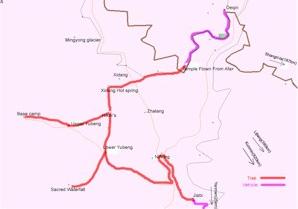
Enlarge to see the route in full size.
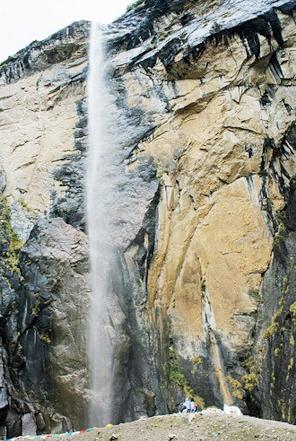
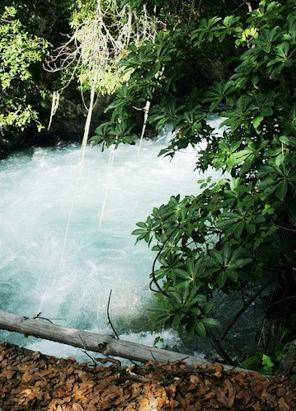
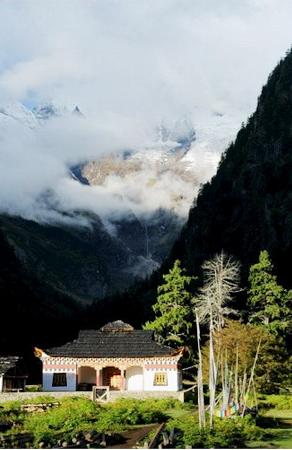
|

